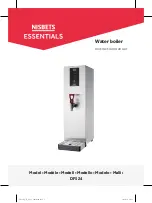
MODE OF OPERATION
5-4
5.5.1 BOILER MANAGEMENT SYSTEM
EXTERNAL FIELD WIRING
Wiring for this system is from the BMS panel,
boilers 1 through 8, to terminals 2 and 3 at the
boiler control wiring terminal strip located at the
bottom left hand corner of the control panel.
Wire the units using a shielded twisted pair of 18
to 22 AWG wire while observing polarity. The
shield is connected at the BMS to any minus (-)
boiler terminal and the boiler end of the shield
must be left floating. Each unit’s wiring must
conform to the above. For a complete BMS
wiring diagram, see wiring schematic #18973
located in Appendix H.
5.5.2 BOILER MANAGEMENT SYSTEM
SETUP AND STARTUP
This mode of operation is factory preset and the
AERCO BMS Model 168 controls the firing rate.
There are no setup instructions for each
individual unit. To operate
the unit in manual
mode, the temperature controller must be
taken out of REMOTE mode and set to
LOCAL mode
To set the unit in manual mode do the following:
1. Access the temperature controller’s
secondary menu.
2. Scroll through the menu until "lore" is
displayed.
3. Use the
⇑
and
⇓
arrow keys to set the
temperature controller to local. The yellow
REM light, on the temperature controller,
should extinguish
4. Press ENTER to accept the change.
5. Follow the above directions to set the unit
for up to be controlled by the BMS.
NOTE:
The unit automatically defaults to remote
mode whenever AC power is removed and
then applied. This is due to the presence of
the external interface board
.
5.6 COMBINATION CONTROL SYSTEM
(CCP)
A Combination Control System is a system
where multiple boilers are used to cover both
space heating and domestic hot water needs.
An AERCO Boiler Management System and
Combination Control Panel are necessary for
this system. Typically enough boilers are
installed to cover the space-heating load on the
design day, however one or more units are used
for the domestic load.
The theory behind this system is that the
maximum space-heating load and the maximum
domestic hot water load do not occur
simultaneously. The boilers used for the
domestic hot water are capable of switching
between constant setpoint and BMS modes of
operation. These boilers are the combination
units and are referred to as the combo boilers.
The combo boilers heat water to a constant
setpoint temperature. That water is then
circulated through a heat exchanger in a
domestic hot water storage tank.
When the space-heating load is such that all the
space-heating boilers are at 100% firing rate, the
BMS will then ask the Combination Control
Panel for the domestic boiler(s) to become
space-heating boilers. Provided the domestic
hot water load is satisfied the domestic boilers
will then become space-heating boilers. If the
domestic hot water load is not satisfied, the
combo boilers remain on the domestic load. If
the combo boilers switch over to space heating
but there is a call for domestic hot water, the
CCP switches the combo units back to the
domestic load.
When the combo units are satisfying the
domestic load they are in constant setpoint
mode of operation. When the combo units
switch over to space heating, their mode of
operation becomes BMS mode. For more
information concerning the operation of the
Combination Control Panel see the AERCO
CCP-1 literature.
MENU
FUNCTION
SETTING
Secondary
Lore
Re
Secondary
FUNC
Cont
Primary
Auto
ON
5.6.1 COMBINATION CONTROL SYSTEM
FIELD WIRING
Wiring for this system is between the BMS
panel, the CCP and terminals 2 and 3 on the
control wiring terminals located in the control
box. Wire the units using a shielded twisted pair
of 18 to 22 AWG wire. When wiring multiple
units, each unit’s wiring must conform to the
above. For a complete CCP system-wiring
diagram see the AERCO CCP-1 literature.
Summary of Contents for Benchmark G-00-711
Page 62: ...APPENDIX C ix Temperature Sensor Resistance Chart Balco ...
Page 69: ...APPENDIX F xvi ...
Page 70: ...APPENDIX F xvii ...
Page 71: ...APPENDIX F xviii ...
Page 72: ...APPENDIX F xix ...
Page 73: ...APPENDIX F xx ...
Page 74: ...APPENDIX G xviii ...
Page 75: ...APPENDIX G xix ...
Page 76: ...APPENDIX H xxi ...
















































